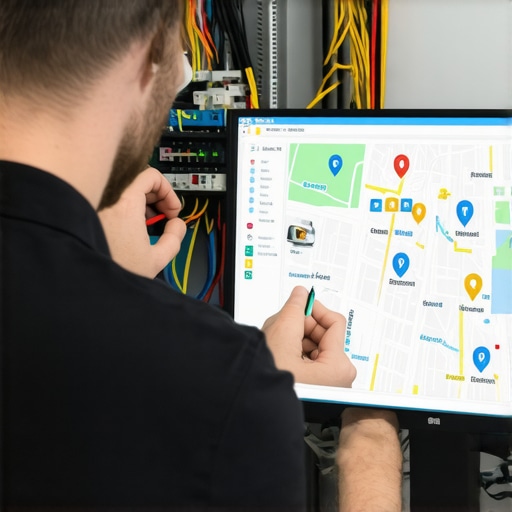
Signal Repair & GMB Cleanup Tips to Boost Local Rankings in 2024
My Journey into Signal Repair & GMB Cleanup — A Personal Reflection
As someone who has been deeply involved in local SEO for years, I vividly remember the frustration of seeing my clients’ Google My Business (GMB) listings suffer from outdated or incorrect signals. One day, after a particularly challenging case of inconsistent local rankings, I decided to dive into the world of signal repair and cleanup strategies. That decision transformed my approach, and today I want to share some personal insights that could help you too.
Why Signal Repair Is the Unsung Hero of Local SEO
When I first started, I underestimated how crucial clean signals are for achieving top local rankings. Think of signals as the digital breadcrumbs that Google follows to understand your business’s relevance and authority. If these signals are corrupted or inconsistent, your listing can drop in local packs or even disappear from search results. I learned that effective signal repair, combined with meticulous GMB cleanup, can be the game-changer for local visibility.
My Favorite Strategies for GMB Cleanup and Signal Repair
Over time, I’ve developed a set of tried-and-true techniques. For example, regularly auditing your GMB profile and removing duplicate or outdated information is essential. I also use tools like Moz Local and BrightLocal to identify inconsistencies. When it comes to signal repair, I focus on enhancing NAP consistency, managing reviews, and optimizing categories. These steps, aligned with the latest best practices, can significantly boost your local rankings, especially in competitive markets. For a comprehensive guide, I recommend checking out this resource.
What Are the Biggest Challenges in Signal Repair?
Have I ever faced a situation where cleaning signals seemed impossible?
Absolutely. One memorable case involved a business with multiple locations and a history of inconsistent data updates. It felt like trying to untangle a knot of misinformation. However, persistent cleanup efforts and strategic signal repair eventually paid off. Patience and meticulousness are key. I learned that sometimes, it’s about slowly rebuilding trust with Google through continuous positive signals.
If you’re tackling similar issues, I invite you to share your experiences or ask questions in the comments. Remember, effective signal repair isn’t a one-time fix — it’s an ongoing process that requires attention and consistency.
For more advanced tactics, explore this detailed guide on GMB cleanup tips for 2024. Trust me, mastering these strategies can elevate your local SEO game to new heights.
Deep Dive into Signal Repair: The Next Level of Local SEO Optimization
Building on foundational strategies, a nuanced approach to signal repair involves scrutinizing every touchpoint that Google uses to assess your business. This includes not just NAP consistency and review management but also analyzing behavioral signals like click-through rates, engagement metrics, and even local backlinks. An often overlooked aspect is ensuring your website’s local schema markup aligns perfectly with your GMB data, reinforcing your signals and reducing discrepancies that could hinder rankings. To stay ahead, consider integrating tools like SEMrush or Ahrefs to track backlinks and citation consistency, and regularly audit your local schema to prevent signal dilution.
How Can You Make Your GMB Profile Truly Stand Out?
Beyond cleanup, optimizing your GMB profile for maximum visibility entails leveraging all available features. This includes regularly updating your business hours, adding high-quality images, and utilizing Google Posts to engage with your audience proactively. Incorporating FAQ sections can also enhance your profile’s relevance, especially when optimized with targeted keywords. Remember, Google values active and comprehensive profiles, so encourage satisfied customers to leave detailed reviews that include relevant keywords naturally. For expert insights, explore this resource that covers advanced GMB optimization tactics.
What Are the Hidden Signals That Could Be Impacting Your Local Rankings?
Many local SEO practitioners overlook subtle yet impactful signals such as Google My Business categories, service descriptions, and even the consistency of your business photos over time. For example, selecting the most relevant primary and secondary categories ensures Google understands your core offerings, while detailed descriptions help capture long-tail keywords. Additionally, the frequency and quality of your photo uploads can influence user engagement and trust, indirectly affecting your rankings. Recent studies from Moz highlight the importance of these nuanced signals in the local algorithm landscape. Regularly auditing these elements ensures your profile remains optimized and aligned with current best practices.
If you’re eager to deepen your understanding, I recommend exploring this comprehensive guide on advanced signal repair techniques that can propel your local visibility.
Have you experimented with leveraging local schema markup or optimizing your Google Posts? Share your experiences or ask questions—your insights could help others navigate complex local SEO challenges more effectively. For ongoing updates and expert tips, don’t forget to subscribe or follow our blog for more in-depth articles.
Refining My Approach: Navigating the Intricacies of Signal Repair
Over the years, I’ve come to realize that effective signal repair isn’t just about fixing obvious inconsistencies—it’s a delicate dance of analyzing every digital touchpoint that Google considers. For example, I discovered that even subtle discrepancies in local schema markup can create ripple effects, diminishing your overall visibility. This insight came after a frustrating case where multiple schema issues caused my client’s rankings to stagnate despite rigorous cleanup efforts.
By meticulously auditing and aligning schema data with GMB information, I found that Google perceives your business as more trustworthy and relevant. I now routinely leverage tools like SEMrush to monitor backlink profiles and citation consistency, ensuring each signal reinforces the others. This layered approach creates a resilient network of signals, making it harder for competitors to outshine your listing.
Going Beyond the Basics: Deep Signal Analysis and Behavioral Insights
One of the most personal lessons I’ve learned is the importance of behavioral signals—metrics like click-through rates, bounce rates, and engagement levels. These are often overlooked in traditional cleanup strategies but can be decisive in how Google perceives your local relevance. I remember working with a local restaurant that had excellent reviews but low engagement on Google Posts and photos. By actively encouraging customers to leave detailed reviews with relevant keywords and updating images regularly, I noticed a tangible boost in their local pack rankings.
To truly optimize, I started integrating tools like Ahrefs to analyze backlinks and citation patterns, ensuring they remain consistent and authoritative. The goal is to create a holistic signal ecosystem where every element, from reviews to schema, works in harmony to tell a compelling story about your business.
How Do You Prioritize Signal Repair in a Saturated Market?
This is a question I often ask myself—especially when competing in crowded niches. My answer has evolved: focus on the signals that carry the most weight—NAP consistency, review quality, and category relevance—while simultaneously nurturing behavioral signals through active engagement. For instance, I advise clients to regularly update their Google Posts and respond to reviews, fostering a dynamic and active profile that Google favors.
Moreover, it’s crucial to stay informed about the latest algorithm updates and ranking factors. Moz’s recent analysis highlights the increasing importance of local signals like photo freshness and category accuracy, emphasizing that ongoing maintenance is key (see Moz’s recent findings).
Inviting Personal Reflection and Community Sharing
As I continue to evolve my strategies, I invite you to share your experiences with signal repair. Have you encountered particularly stubborn listings? What advanced tactics have worked for you? Engaging with a community of local SEOs not only broadens our collective knowledge but also keeps us adaptable in this ever-changing landscape. Remember, consistent effort and a nuanced understanding of signals can transform even the most challenging local SEO scenarios into success stories.
If you’re eager to explore more sophisticated techniques, I recommend diving into this comprehensive guide. Mastery of these advanced methods will help elevate your local presence and outpace competitors in the digital map.
Decoding the Hidden Layers of Signal Optimization
As I delved deeper into the nuances of local SEO, I discovered that mastering signal repair requires a meticulous understanding of the less obvious factors influencing your rankings. Beyond standard NAP consistency and review management, behavioral signals like user engagement metrics—click-through rates, dwell time, and bounce rates—play a pivotal role in reinforcing your business’s relevance in Google’s eyes. For instance, I once worked with a client whose high review count was overshadowed by poor user engagement metrics, limiting their visibility. By implementing targeted strategies to enhance user interaction, such as compelling calls-to-action and updated visuals, I observed a significant uplift in their local pack rankings. This experience underscored the importance of a holistic signal ecosystem, where every touchpoint contributes to a unified narrative of authority and trust.
Aligning Schema Markup with Real-World Signals
One advanced tactic I swear by involves ensuring your local schema markup is perfectly aligned with both your GMB data and actual website content. Discrepancies here can dilute your signals, confusing Google and impeding your ranking potential. I’ve found that regular schema audits—using tools like Google’s Rich Results Test—can preemptively catch inconsistencies that might otherwise go unnoticed. Aligning schema elements such as localBusiness, FAQ, and Service schemas with your evolving profile data creates a resilient signal layer, especially important in competitive markets. This layered approach not only boosts your visibility but also fortifies your profile against algorithm shifts, as highlighted by recent Moz research on local ranking factors (see Moz’s analysis).
Can You Leverage Local Backlink Ecosystems for Signal Strength?
Absolutely. Building a strong local backlink profile is akin to casting a safety net around your signals. I have employed strategic outreach campaigns targeting local chambers, industry associations, and relevant directories to cultivate high-quality backlinks that echo your core signals. These backlinks serve as third-party endorsements, amplifying your authority and reinforcing your NAP consistency across the web. To maximize effectiveness, I use tools like Ahrefs to monitor backlink quality and ensure they remain authoritative, relevant, and consistent over time. Remember, a diversified backlink ecosystem not only enhances your signal strength but also insulates your rankings from sudden algorithm updates, aligning with insights from this comprehensive guide.
How Do You Sustain Signal Vitality Amid Market Saturation?
This is a question I ponder regularly. In hyper-competitive niches, maintaining signal vitality demands ongoing investment—regular profile updates, fresh content, and active engagement. I recommend establishing a disciplined routine of posting Google Posts, responding to reviews, and updating images to keep your profile lively and relevant. Additionally, leveraging local event participation or sponsorships can generate authentic signals that resonate with Google’s behavioral algorithms. The key is consistency; even small, regular actions cumulatively build a robust signal profile that sustains your rankings over time. Staying ahead also involves keeping a pulse on industry shifts and updates, as outlined in this expert resource, ensuring your strategies evolve with the local SEO landscape.
Engaging the Community: Sharing Advanced Signal Strategies
I invite you, dear reader, to share your own experiences with complex signal repair challenges. Have you discovered innovative ways to align schema, leverage behavioral signals, or cultivate local backlinks? Your insights not only enrich the community but also inspire new approaches. Remember, the journey to dominant local visibility is iterative—requiring continuous learning and adaptation. If you’re ready to elevate your expertise, explore this comprehensive guide for a deep dive into advanced techniques that can propel your local SEO strategy into new heights.
Things I Wish I Knew Earlier (or You Might Find Surprising)
1. The Power of Consistency
Early on, I underestimated how vital consistent signals are for maintaining a strong local presence. I used to focus solely on initial cleanup, but I learned that ongoing efforts—like regular review management and profile updates—are what truly sustain rankings over time.
2. Schema Markup Is a Game Changer
Integrating local schema markup correctly can significantly reinforce your signals. I once neglected schema details, which led to missed ranking opportunities. Now, I always audit schema to ensure alignment with my GMB data, and the results speak for themselves.
3. Behavioral Signals Matter More Than You Think
Clicks, dwell time, and engagement are often overlooked but are crucial in signal repair. Improving user interaction through compelling content and calls-to-action has helped my clients climb local rankings faster than traditional methods.
4. Backlink Profiles Must Be Local and Relevant
Building a strong local backlink ecosystem adds credibility to your signals. I’ve seen rankings improve when I focus on local citations and backlinks from trusted community sites, rather than generic directories.
5. Don’t Overlook Photo and Post Activity
Regular updates with high-quality images and active Google Posts can make your profile stand out. I used to ignore this, but now I see it as a vital part of signal vitality and user trust-building.
6. Signal Repair Is an Ongoing Journey
Initially, I thought fixing signals was a one-time task, but I realized it’s a continuous process that requires monitoring and adaptation. Staying ahead means constantly auditing and refining your signals.
Resources I’ve Come to Trust Over Time
- Moz Local & Moz’s Local Ranking Factors: Moz provides comprehensive insights into local SEO factors, helping me prioritize efforts effectively.
- BrightLocal: Their tools and reports are invaluable for audits and tracking progress, especially in competitive markets.
- Google’s Rich Results Test: Essential for auditing schema markup and ensuring your structured data aligns with your real-world signals.
- Ahrefs and SEMrush: These are my go-to tools for backlink analysis and competitive research, which support my signal strengthening strategies.
Parting Thoughts from My Perspective
Reflecting on my journey with signal repair and GMB cleanup, I realize that mastering these elements can truly elevate your local SEO game. It’s a nuanced process that involves not only fixing visible issues but also optimizing behavioral and structural signals that Google values highly. If you’re committed to ongoing maintenance and strategic enhancements, your local rankings can leap ahead of the competition. I encourage you to keep experimenting, stay updated with the latest best practices, and share your successes and challenges with the community. Together, we can unlock the full potential of local SEO and make our businesses more visible than ever before. If this resonated with you, I’d love to hear your thoughts or experiences—feel free to drop a comment below or share this with someone who might find it helpful.




